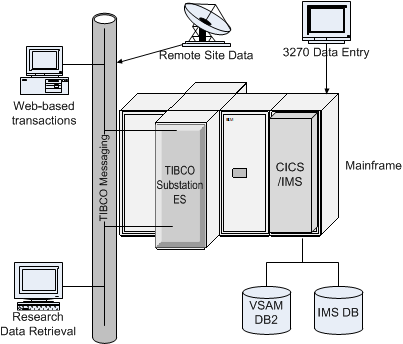Introduction
TIBCO Substation ES™ subscribes to and publishes data to TIBCO applications and transaction processing systems, such as Customer Information Control System (CICS) and Information Management System (IMS), which run in the z/OS operating-system environment.
TIBCO applications are those that can communicate with Substation ES through a messaging protocol supported by Substation ES, for example, TIBCO Rendezvous® and TIBCO Enterprise Message Service™. Examples of such applications include TIBCO BusinessWorks™, TIBCO BusinessEvents®, TIBCO Business Process Management (BPM), message-enabled web applications, and programs that use messaging applications APIs.
- Handling all communications and routing between TIBCO applications and CICS or IMS transaction processing applications. The TIBCO applications can be running anywhere on the network while the transaction processing applications are running in the z/OS environment.
- Translation data between TIBCO applications and the CICS or IMS transaction processing systems. Data mapping and configuration are specified through a series of Interactive System Productivity Facility (ISPF) panels, which define how each field is to be converted based on the direction in which the data is exchanged. Substation ES also includes the facilities for ensuring the integrity of the transactions.
- A flexible set of system startup and initialization parameters, which control the setup and configurations.
- A console interface, remote access, and a web browser application for monitoring and controlling Substation ES after startup.
- Tracing and logging facilities to track the progress of transactions and handle errors.
- Feedback on the Substation ES processing, message handling, and runtime errors by using TIBCO messaging through user data fields.
Substation ES is especially useful at sites that plan to augment the processing capabilities of z/OS applications with newer applications that execute from process engines, application servers or any network-attached devices. In that scenario, system administrators want the flexibility and ease of usage offered by popular data entry systems while retaining the robust back-end processing capabilities of their mainframe systems.
For example, suppose a financial institution wants to make the financial information stored in applications in the z/OS environment more available to its customers. The institution can use Substation ES and TIBCO applications to build a bridge by which customers can submit requests for information from PCs at branch offices or through a web browser on the Internet.
Additionally, applications in the z/OS environment can use Substation ES to publish data or access data generated by other types of applications. The information is transmitted by TIBCO application messages.
For example, a CICS or IMS application can publish a running tally of the number of widgets that have been ordered through an order processing system. With Substation ES, this information can be made available to company employees worldwide over their intranet.
As another example, the institution can use Substation ES to subscribe to events and notify transaction processing applications on z/OS when an order is processed in one of branches of the institution. The branches can be using a PC-based order-taking system and local database, but the applications on z/OS can stay informed.
The following figure shows some of the flexibility that can be designed into a system-wide enterprise, where information must be shared between applications on different operating systems and a mix of computing platforms.

